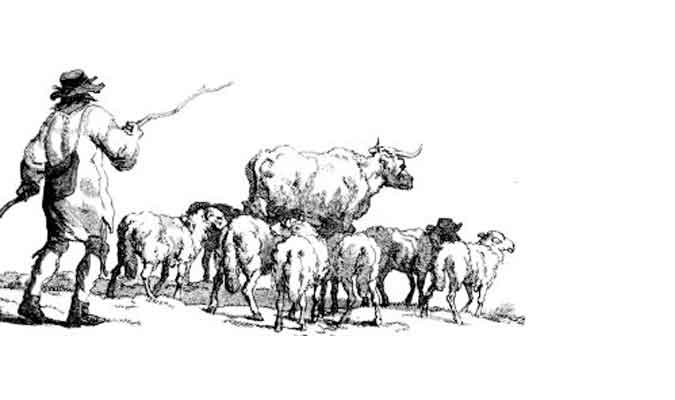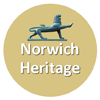
Medieval Wares from Norwich Market
Pass your cursor over the thumbnails bordering the Norwich medieval market plan below to see the type of wares for sale
and where we believe the various traders were located c1300 (courtesy Ursula Priestley - The Great Market)
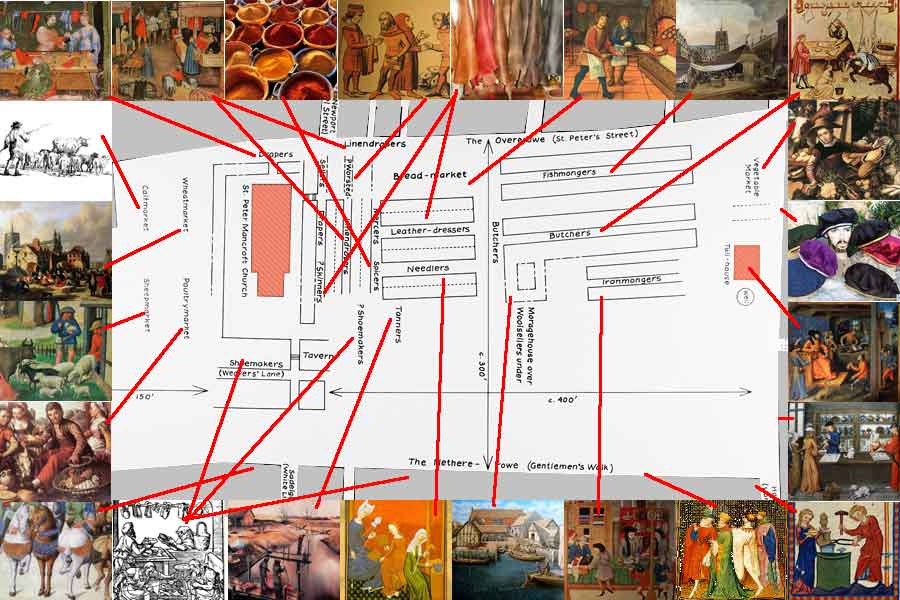

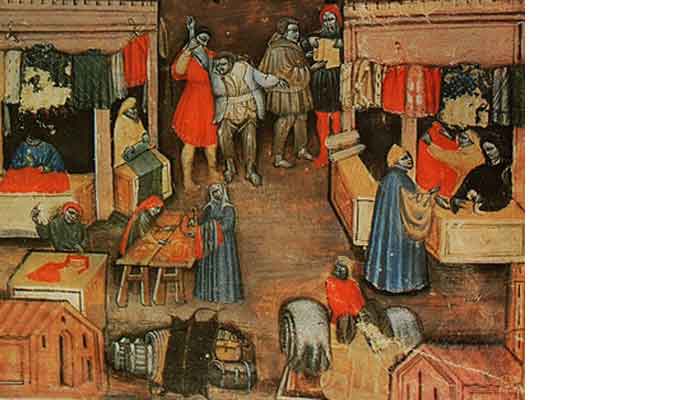
Linendrapers
By the end of the 13th century linen products were established as luxury items. Owners of stalls in the "lindraeria" or Linendrapers' Row in the market are likely to have purchased their linen cloth from producers in the parishes around Aylsham (n.b.some linens were known as "aylshams"). They could then arrange for it to be dyed before selling it on either for home use or to general merchants for wider distribution.
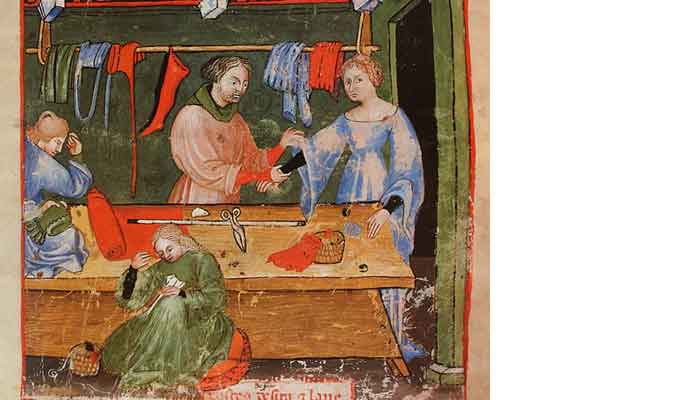
Drapers Stall
Drapers dealt in broadcloth (fulled woollen cloth). They would have bought local cloth from the producers, organised its finishing with the fullers & dyers and sold the final product on the market. A third of drapers would have owned their own market stalls in the "drapery" also known as the "Omanseterow". It is likely they would have also dealt in cloth from the Continent.

Spice Stall
The spices introduced during the Middle Ages often came from the Eastern lands which the Crusaders travelled through to reach Jerusalem. The importation of spices resulted in a highly spiced cuisine for the nobility and spices were seen as a sign of wealth thus generally, the higher the rank of a household, the greater its use of spices. Spices such as cumin & aniseed were imported into Norwich whilst principal items e.g ginger & pepper were probably purchased from London wholesalers.

Worsted Stall
Worsted was one of the main types of woollen cloth available in the Medieval period. Longer, thicker fibers of more or less equal lengths were spun into worsted yarn, which would be used to weave worsted cloth that was fairly lightweight and sturdy. The term has its source in the Norfolk village of Worstead, which in the early Middle Ages was a thriving center of cloth production. Textile production was a major industry in Norwich. Thus not surprisingly it was sold on Norwich market.

Leather Dressers & Skinners
According to Ursula Priestley in medieval times the leather industry was predominant in Norwich which is reflected in the number of stalls given over to leather working, including "leather dressers" and skinners

Bread Market
The growth of towns and cities throughout the Middle Ages saw a steady increase in trade and bakers began to set up in business.c1150 guilds were introduced to protect the interests of members and to regulate controls governing the price and weight of bread. Bread was cheap and hence an important source of food for the poor, for a casual labourer earning 1d a day a halfpenny pie woull be a rare extravagance

Fish Market
The "Old Fishmarket," pictured here in a painting by Charles Hodgson c1821 (reproduced by permission of the Norfolk Museum Service) stood on the same site for more than seven centuries before being replaced c1860. Fish was was a vital part of the medieval diet, partly because of the high number of fast days. Herring, brought in from Great Yamouth was one of the major fish consumed however, a wide choice of other salt and freshwater fish would have been sold.

Meat Market
Butchers traded from permanent stalls on the market. Medieval butchery was a messy business with the detrius often deposited in waterways which led into domestic water supplies. Thus butchers (preparing animals for market) were largely confined to higher ground to the South & S. West making it possible to keep the Wesum free of entrails & carcasses as it flowed through Norwich!

Vegetable Market
The term "vegetable" was rarely used, the term "herb" covered all green plants, roots and herbs. Food items which came from the ground were thought only fit for the poor. Only vegetables such as rape, onions, garlic and leeks would have graced a Noble's table. Vegetables were the staple food of the population and unlike today were never considered as being nutritious, since they were almost exclusively used by monastic communities when under vows of extreme abstinence.
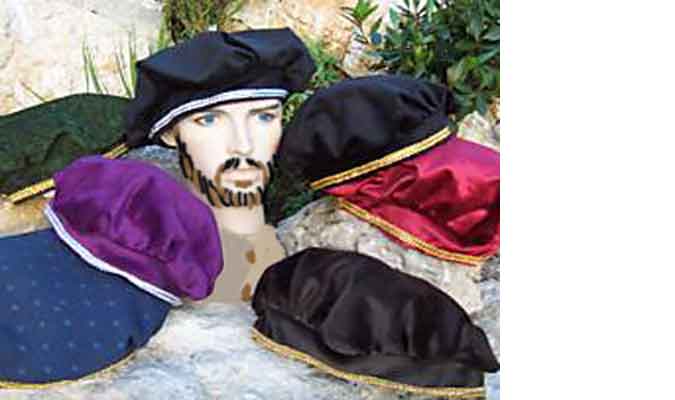
The Hatters
The hatters sold their wares on the periphery of the market. As now medieval clothes provided information about the status of the person wearing them with fashion being highly influenced by the Kings and Queens of the era. At this time hat & cap making was one of Norwich's minor trades and catered for a purely local market.
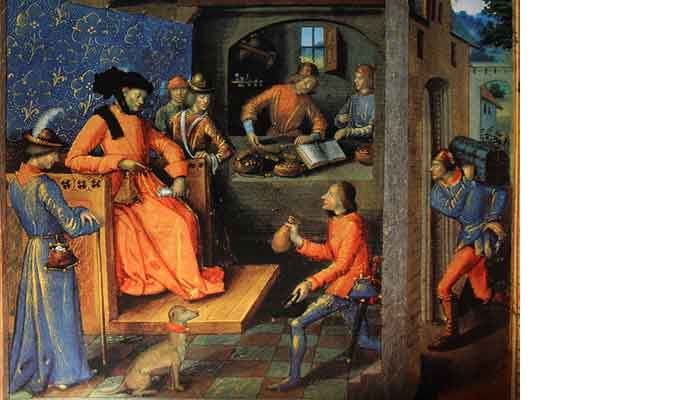
The Tollhouse
The Tollhouse would have been built very soon after the establishment of the market at the end of the 11th century, as a collection point for the tolls and taxes exacted by the Crown. Soon therafter it also became Norwich's civil & judicial Headquarters. In 1407 it was replaced by present Guildhall, which was almost certainly erected on the same site.
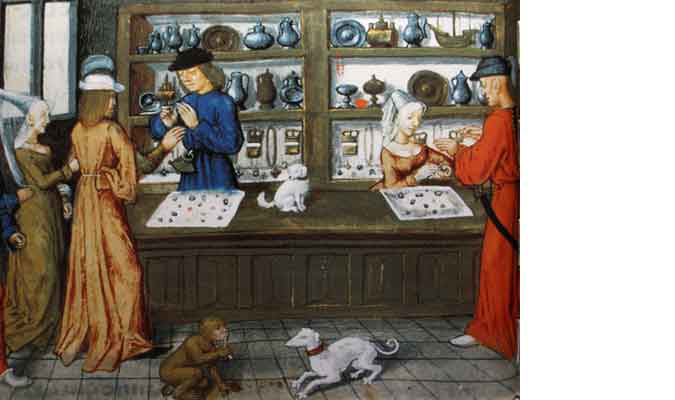
Goldsmiths
The Norwich Goldsmiths, operated on the periphery of the market. They would have been one of the most important and wealthy in the city and have kept records of members and the marks they used on their products. They often also acted as bankers since they dealt in gold and tended to have sufficient security for the storage of valuable items.
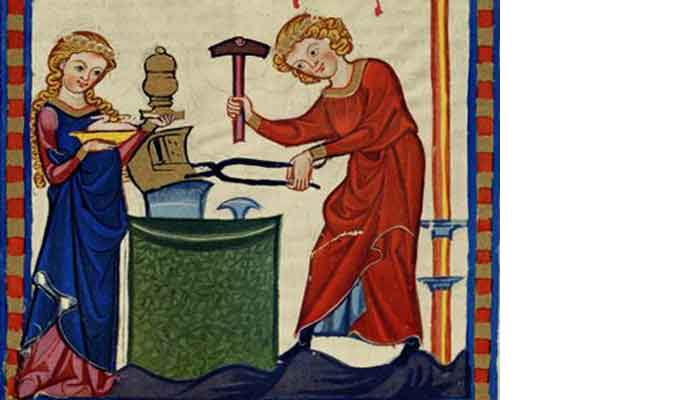
Cutlers Market
Cutlers sold their wares on the periphery of the market Cutlery was not widely used in Medieval Britain. Spoons would generally be made of wood or bone for the peasants and iron for the nobility. Knives were made of metal although people normally used their beltknife rather than a specialised implement. If there was knife on the table it was shared. Only the very wealthy would set their tables with cutlery on a regular basis.
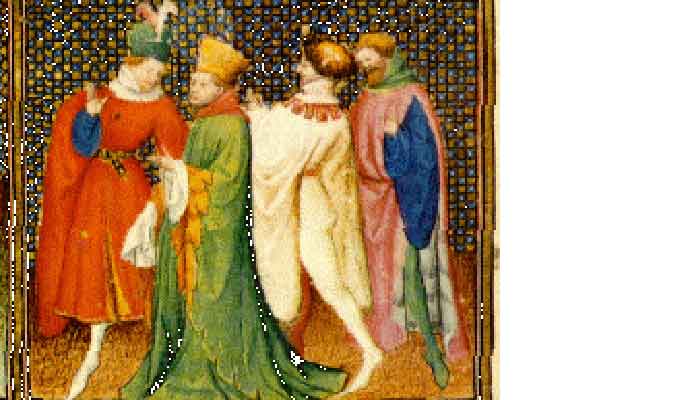
Hosiers Stalls
Hosiers, also known as calgarii or chaucers, occupied a quarter on the east side of the market. Although in the early 14th century hosiers were relatively rich their numbers/ wealth declined as the century progressed. This is believed to have been because the production of woollen hose (a relatively large market) had passed to the tailors leaving them to supply the much smaller market for leather hose.
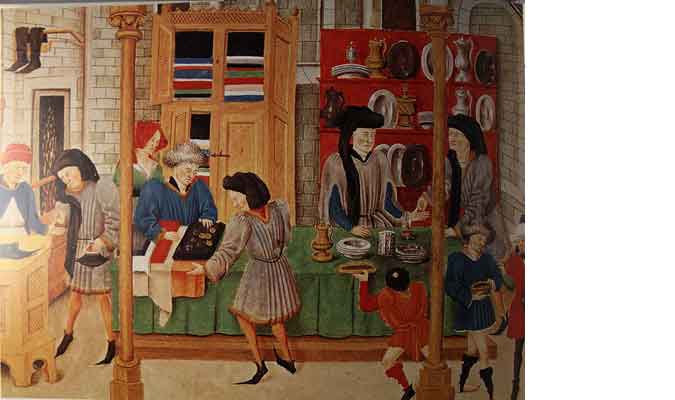
Ironmongers
The ironmongers traded in miscellaneous iron goods and hardware. Thet had stalls on the market in front of the butchers & fishmongers
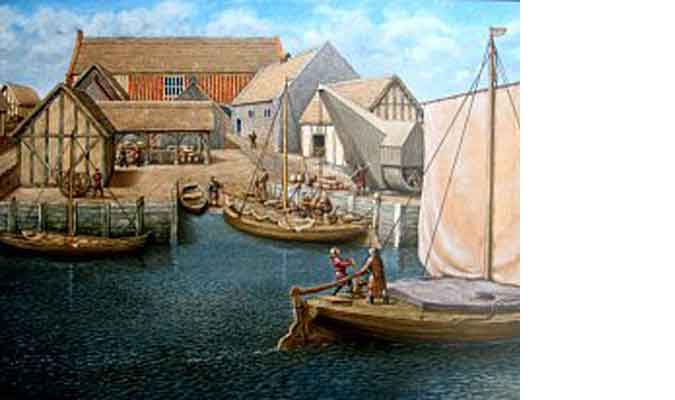
Woolsellers & Murage Loft
"The Murage Loft" was used for the collection of the tolls levied after 1924 for the erection of the city's stone walls. It was located over the woolsellers. in 1300 Norwich was not a leading wool producer, indeed its wool was of comparatively low quality valued at about £4 for a 26 stone sack.
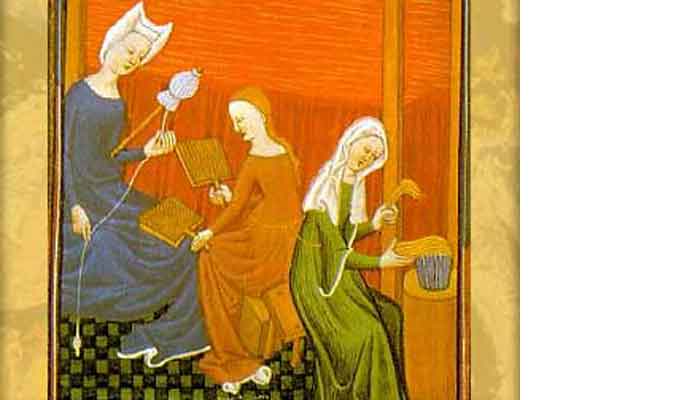
Needlers
Metal working was an important medieval industry in Norwich. Alson with needles, the metal would have been used to make a large range of goods including: armour, bells & cutlery
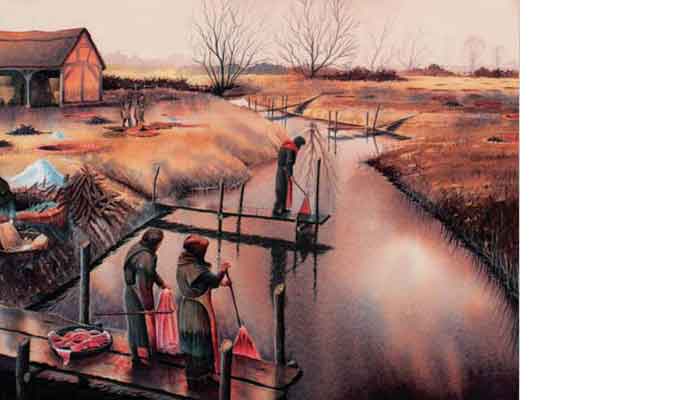
Tanners Market
The tanners cured cattle hides with bark. Although at the turn of the 14th century leather production was strong, employing approx 7% of all workers in Norwich, as the century progressed there was a decline in the number of tanners operating within the city. They seem to have had a tendency to move upstream, outside the city walls, as a reaction against rival demands from the cloth industry for water.

Shoemakers
Shoemakers variously called:bootmakers,chaucers or cordwainers traded on the market.It appears from the number of shoes ordered from the 13th century onwards that there was some form of mass production in "readymade" shoes, as opposed to the traditional "bespoke" shoes What this meant for sizes is unclear, although three different prices given at this time infers that there were at least three basic sizes.
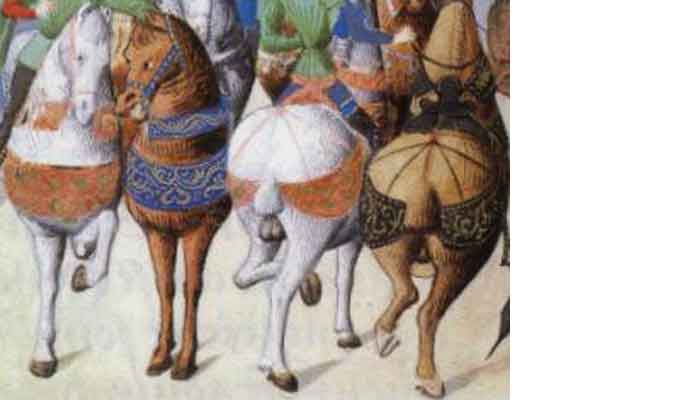
Saddlers
Saddlery is principally a leather trade. The craft has been established in England as a separate trade since the 13th century, when the London Saddlers' Company received its charter from Edward I. In 1300 Norwich leather production was a major industry however, only a small number of artisans would have been involved in making sadles & bridles which were sold on "Saddlegate" (a street leading to the market place), now called White Lion Street.

Poultry Market
In 1300 cattle, sheep & poultry were sold in the open space to the south of St Peter Mancroft Church. By 1700 the congestion & chaos of bringing live animals to the site had become intolerable. Even so it was not until 1738, that the weekly livestock sales were transferred to the "new" cattle market, now covered by the Castle Mall shopping centre.

Sheep Market
In 1300 cattle, sheep & poultry were sold in the open space to the south of St Peter Mancroft Church. By 1700 the congestion & chaos of bringing live animals to the site had become intolerable. Even so it was not until 1738, that the weekly livestock sales were transferred to the "new" cattle market, now covered by the Castle Mall shopping centre.
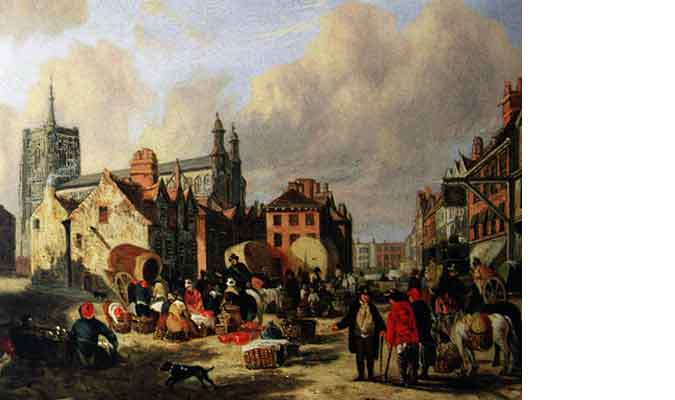
Wheat Market
By 1300 Norwich was of a sufficient size to affect the region's agricultural production. By 1330 the population had grown to about 25,000 & it is estimated that it would require 41,250 quarters of grain p.a. to provide bread & ale. Both Wheat (& the cheaper)oats were on sale in Norwich but it is likely that barley bread was more likely to have been consumed by the urban poor. This general area is still called "The Haymarket"
